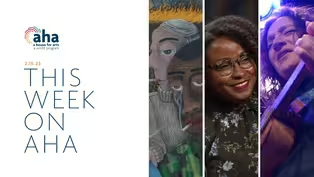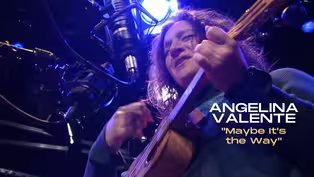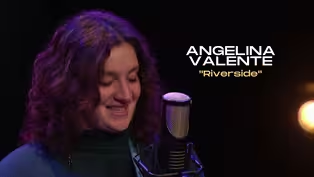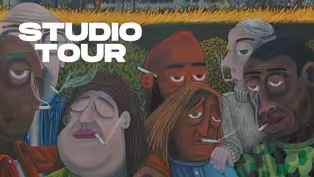
Finding Inspiration in Nature: The Art of Takeyce Walter
Clip: Season 8 Episode 19 | 10m 39sVideo has Closed Captions
Discover how landscape painter Takeyce Walter empowers others through art.
Join us as we explore the breathtaking landscapes and inspiring artwork of Takeyce Walter. Through her popular Creative February challenge and uplifting workshops, this talented painter uses her art to spread joy and inspire others. See how she captures the beauty of nature in her paintings and how you too can find inspiration in the world around you.
Problems playing video? | Closed Captioning Feedback
Problems playing video? | Closed Captioning Feedback
AHA! A House for Arts is a local public television program presented by WMHT
Support provided by the New York State Council on the Arts (NYSCA), M&T Bank, the Leo Cox Beach Philanthropic Foundation, and is also provided by contributors to the WMHT Venture...

Finding Inspiration in Nature: The Art of Takeyce Walter
Clip: Season 8 Episode 19 | 10m 39sVideo has Closed Captions
Join us as we explore the breathtaking landscapes and inspiring artwork of Takeyce Walter. Through her popular Creative February challenge and uplifting workshops, this talented painter uses her art to spread joy and inspire others. See how she captures the beauty of nature in her paintings and how you too can find inspiration in the world around you.
Problems playing video? | Closed Captioning Feedback
How to Watch AHA! A House for Arts
AHA! A House for Arts is available to stream on pbs.org and the free PBS App, available on iPhone, Apple TV, Android TV, Android smartphones, Amazon Fire TV, Amazon Fire Tablet, Roku, Samsung Smart TV, and Vizio.
Providing Support for PBS.org
Learn Moreabout PBS online sponsorship- Why landscape and why is that important to you?
- Sure, so the landscape has been important to me ever since I was a child, it's where I go to relax, to rest, to recreate, as an adult, I often am on a lake or hiking with my family, fishing, swimming, and the sense of connection and peace that I have while I'm in the landscape is so important to me to share with others.
- So beautiful, right?
Now you don't see a lot of figures in your art, so I always wanted to ask do you ever think you'll put figures whether it's human, maybe a deer, I don't know, what are your thoughts?
- Yeah, so for the past, I wanna say 10 to 15 years, my aim with landscape, as I mentioned, I go there for peace and I've purposefully removed, sometimes I'll paint something I'll purposefully remove any element of humanity in the landscape because I really just want that raw land but more recently, especially watching my kids in the landscape, I've been curious and now have this yearning to see people in the landscape.
I feel that as a society in general we've kind of separated ourselves from nature and I don't think that's a good way to be.
No, so I think it's important for me to include humans 'cause we are a part of nature and we do need to be connected.
Some of my most wonderful core memories are of spending time in nature with my family, so, I wanna explore more of that in my art.
- Oh, it's beautiful, really true, capturing memories of just not only your enjoyment in nature, probably pre being a mother but also now capturing those same memories but now with your children within it which is like, kind of like, it's like double memories, you know?
It's like I had this one memory, we're in the same space but now I'm being able to witness the beauty of my family being able to enjoy this and I wanna capture that as well, which I think is a really beautiful thing.
- Thank you.
- So, I wanna talk a little bit about Black artists within landscape work, personally, I feel like you don't really see that many Black artists in exhibitions or exhibited through artistic organizations, really highlighting Black landscape artists.
Is that something that you feel as well?
And if so, why do you think that?
- Yeah, you know, when I got an interest in landscape painting, I remember taking a field trip, it was a field trip for either a college course or a high school course for art and we went to the Met in New York and I remember just being in front of this painting and it just stopped me in my tracks.
Like, I probably stood there for a very long time, I was moved almost to tears by this painting and it was a landscape painting but it had water in it and even though it was done in the early 19th century, it had such a contemporary feeling to it and was just really beautiful, I can't explain just the feeling of peace that came over me from seeing that.
And that's when I knew I wanted to explore landscape as a way to express myself through painting.
So after that and walking through the Met, there were many folks that were from the African diaspora represented and I tried to do research to find other artists particularly landscape artists to learn from 'cause that's, you know, as artists, you kinda learn from role models and what you see, a lot of the painters that I found at least the ones who were celebrated and in the museums and books were written about were many European older white men and handful of women and then I grew to understand that during that time, folks of the African diaspora, other minorities, were not a part of that environment, we weren't permitted to be, you know, educated or gain an education in art.
Folks of the African diaspora in America have sometimes like a conflicted relationship with the landscape.
Now, I'm Jamaican, I am an immigrant to this country, so I don't pretend to know, you know, or know what it's like to be someone of the African diaspora in this country but I know that the access wasn't there and to learn landscape, with anything, you have to learn from observing, you know?
So I go out in the field all the time to study my subject, to practice painting, and then bring that back to my studio, going outdoors for folks of color during, you know, the reconstruction era it wasn't necessarily the safest thing to do, so I can imagine that historically that could have been a factor of why you didn't see a lot of landscape painters, back during the Jim Crow era you had the Highwaymen in Florida, which were a group of several Black painters who were mainly men, I think there was one woman, one woman who painted the Floridian landscape that they were beautiful but yeah, I've been able to only find a handful of female Black artist who are notable enough to be written in history.
I'm sure they were, you know, artists who were trying to do their thing or amateur artists who were painting landscapes, but in terms of who's celebrated and written about, there aren't many, no.
- So what is something that, if you could say to the folks watching who have the power to give these types of artists, you know, artists of color who work within nature derived in landscape art, what would you tell those people?
How could they make sure that Black artists have access to this type of craft?
- I would say, you know, for those who are privileged and in the realm that they have the power to give folks access is to provide that access, show upcoming art students, kids, they show them that there are landscape painters out there of all different, you know, ethnicities and backgrounds and experiences.
For me to be a landscape painter today, you know, in 2023 America, it's a privilege for me, I'm able to share that with others, I started a youth program with a couple of nonprofits in the area to give youth access to art and the environment, that's actually the name of the program, Art and The Environment, and I worked with the Nature Conservancy, I'm a member of their board in the Adirondack chapter and also with Black Dimensions in Art which is a local art nonprofit, we had 10 youths from the Albany area and we went to various preserves that are stewarded by the the Nature Conservancy and we brought our watercolors, so we hiked, we went to a waterfall, we went to the Albany Pine Bush, and the kids were just so engaged, they were so connected and centered with what was going on, they were looking at the various plant life and trying to identify them with, you know, the nature Conservancy had a couple of their stewards with us and it was such a fulfilling and rewarding experience.
- So I wanna ask you one more thing is Creative February, so you have these beautiful youth programs and I know you have some for adults as well but I know you also do something with Creative February which also helps uplifts artists, so would you give us a little bit of information about that?
- Oh yeah, absolutely.
And today's Happy Creative February.
- Yeah, first day.
- Yes, so Creative February is, it's now become a community art project that started really as a personal art project about nine years ago.
I, as a working mom and artist, you know, I was struggling to find time to commit and dedicate to my art and that year for my birthday, I told my husband I just need some time in my studio with me and my art supplies, that's it.
- That's all we all want.
- That's the dream, and he said, okay, you know, and I was like, oh, all right.
So this is what we're doing and I have a good friend who shares my birthday, she's also an excellent artist, her name is Kate Edwards, and I called Kate up and I said, Kate, this is what we're doing for our birthday this year, that first year we did accomplish the goal of working on something every single day, we had a show that year, it was called Every Day at the Spring Street Gallery in Saratoga Springs and subsequent years, you know, we've kept going and as the movement grew, we started inviting other artists to participate, now we have a dedicated social media presence, we have a Facebook group, we also have a branded hashtag, Creative February, that we use online to connect with others.
- It's only getting bigger, so folks follow Creative February or Facebook also hashtag it.
Well, thank you Takeyce, it was great talking to you about all your passions and how much you do provide to the creative community and I enjoy speaking to you today.
- Thanks so much for having me, Jade.
Video has Closed Captions
Preview: S8 Ep19 | 30s | Journey through the human experience with paintings, landscapes, and music. (30s)
Angelina Valente Performs "Maybe It's the Way"
Video has Closed Captions
Clip: S8 Ep19 | 4m 13s | Singer Angelina Valente and JP Hubbs bring the groove with "Maybe It's the Way." (4m 13s)
Angelina Valente Performs "Riverside"
Video has Closed Captions
Clip: S8 Ep19 | 3m | Catch Angelina Valente's soulful performance of "Riverside" featuring JP Hubbs on keys. (3m)
Exploring the Human Condition Through Brian Cirmo's Painting
Video has Closed Captions
Clip: S8 Ep19 | 5m 39s | Brian Cirmo's paintings offer a unique perspective on the human condition. (5m 39s)
Providing Support for PBS.org
Learn Moreabout PBS online sponsorship

- Arts and Music

Innovative musicians from every genre perform live in the longest-running music series.












Support for PBS provided by:
AHA! A House for Arts is a local public television program presented by WMHT
Support provided by the New York State Council on the Arts (NYSCA), M&T Bank, the Leo Cox Beach Philanthropic Foundation, and is also provided by contributors to the WMHT Venture...




